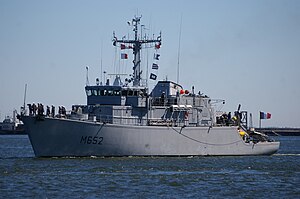Hi
Here's a plot that I put together awhile ago showing how the listed internal volume of some real world ocean going ships and designs compare to their "hydrostatic displacement", where "hydrostatic displacement is basically what youfind for modern warships on the internet and reference books, and whih is basically equal to the weight of the ship and everything on it, per archimedes rule.

The plot shows the amphibious ship that I had mentioned earlier, along with similar data for a similar French(?) ship, as orange circles. The red diamonds are real world surface combatants (like destroyers and frigates - and some Coast Guard type vessels). The green triangles aredesign studies from various tehnical papers, etc, and the blue squares are for some mine counter measures vessels that I had a paper on.Finally, the black squaes are for submarines and the purple squares are based on some really rough hand caacs that I did my self for WWI era battleships, just to see how they world compare to more modern vessels.
What you can see here is that:
For submarines - a 1000 metric tonne ship wouldhave an internal volume of about 1000*0.0732 = 73.2 dtons (where 73.2 x 14 cubic meters/dton = 1024.8 cubic meters).
Or looking at it another way,






Regards
PF
Finding a picture of a Destroyer or Frigate of comparable weight/displacement would probably give you a better idea of size.)
Here's a plot that I put together awhile ago showing how the listed internal volume of some real world ocean going ships and designs compare to their "hydrostatic displacement", where "hydrostatic displacement is basically what youfind for modern warships on the internet and reference books, and whih is basically equal to the weight of the ship and everything on it, per archimedes rule.

The plot shows the amphibious ship that I had mentioned earlier, along with similar data for a similar French(?) ship, as orange circles. The red diamonds are real world surface combatants (like destroyers and frigates - and some Coast Guard type vessels). The green triangles aredesign studies from various tehnical papers, etc, and the blue squares are for some mine counter measures vessels that I had a paper on.Finally, the black squaes are for submarines and the purple squares are based on some really rough hand caacs that I did my self for WWI era battleships, just to see how they world compare to more modern vessels.
What you can see here is that:
For submarines - a 1000 metric tonne ship wouldhave an internal volume of about 1000*0.0732 = 73.2 dtons (where 73.2 x 14 cubic meters/dton = 1024.8 cubic meters).
Or looking at it another way,
- A small diesel electric sub like a German Type 209 might be about 131 dtons (in Traveller terms)
- A mine vessel like the European Tri-Partite class might be about 151 dtons
- a Coast guard cutter like the USCG's 270ft class, might be about 450 dtons
- a Frigate like the USN's FFG7 might be about 1025 dtons
- a Destroyer like the USN's DDG 51 might be about 2250 dtons
- while a WWI era battleship like HMS Dreadnought would be about 3160 dtons (or so)





Regards
PF
Last edited:
